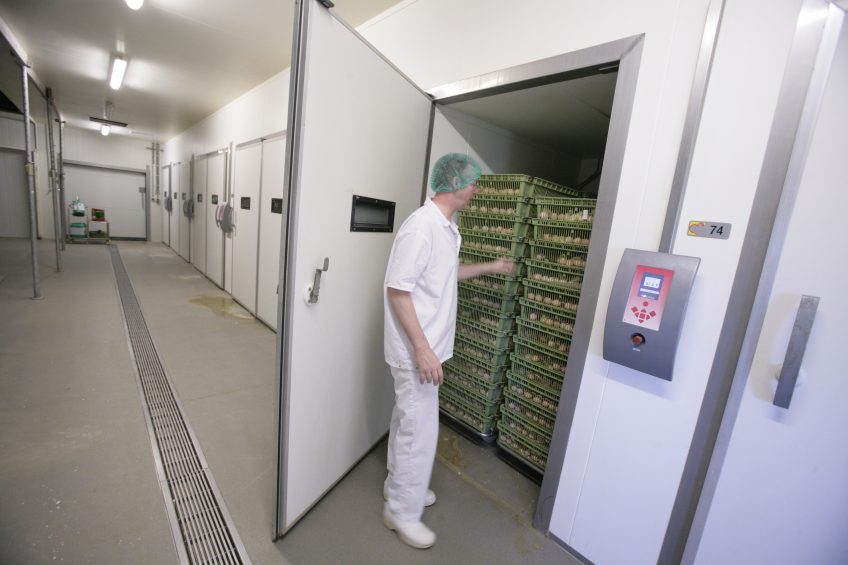Top quality chicks, a checklist

What to expect as a customer from the hatchery? The answer should be simple; top quality chicks of either a broiler chicken breed or a commercial egg layer breed. These chicks should not be hatched in the same hatchery under any circumstances. Expert Ken Marshall shares his experience.
Every hatchery says their chicks are top quality, or so they believe. You, as a customer, have to accept what you are told, and rightly so, unless you know chicks really well and even then it can be difficult. My first job in the poultry industry was as a hatchery manager, something that I had never anticipated. However, after having spent some four years at college and university, learning about poultry and people, it seemed a reasonable place to begin. Although debatable, it really is the heart of the industry.
A top quality chick makes all the difference during production, but what is the definition of a top quality day old chick. It should read like this.
– Eyes clear and bright
– Body dry – not wet
– A body temperature at the vent (cloaca) 35.5°C,
– No cross beaks
– Feet properly formed
– Legs clean, no red hocks
– No signs of gasping or heavy breathing
– No stringy navels
– No black buttons
– Navels properly healed
– Well developed legs, skin that is soft and well hydrated
– No thick/fat bellies
– Not a large amount of growth on the primaries
– Fairly even wing feather growth throughout all the chicks
– A non-stressful (contented-happy) chirp.

It is important that the eggs set for your order should all be from the same flock. The egg age from this flock should be no older than 7 days and preferably not more than 4 to 5 days. Also, the eggs should be from a parent flock no younger than 26 weeks and no older than 61- 64 weeks for broiler chicks, and 70 – 72 – 74 wks for commercial egg layer chicks. The chicks body weight prior to crating or boxing, not less than 35g with a CV (coefficient of variation) of at least 97% giving a weight range of 33.95g to 36.05g (the customer needs to be notified by phone at least 72 hours before chicks’ arrival). If transport distance means chicks will not arrive on the same day of hatch they should not be delivered, but can be delivered to a nearby customer. If neither of these prevails then eggs this size should not be set in the first place.
Alternatively, the batch should be sold at a markedly lower price of at least 20% and even then you will find it difficult to make up the lower weight by 35 days. Compensatory growth, as was talked about, I do not think can make up the difference in weight by day 35. In any case, check for other abnormalities such as Red Hocks. If that is seen, the weight loss was not high enough during incubation due to a too high humidity setting in the hatcher, this can cause chicks to hatch with an overly large belly. In order to get out of the egg the chicks have to work too hard to break out of the shell, this can cause damage to the hocks. Incorrect temperature and humidity in the hatchery can also play a detrimental effect to overall chick quality.
Broiler chicks’ checklist
I would like to see chicks being sold per 100 on a body weight basis, providing that their CV is not less than 97%. Even a good stockman will never make 200g body weight at seven days, let alone 190g with 34g to 36g chicks. The 97% CV may help attain this goal, however I doubt if it can be reached. You should be receiving chicks in the range 38+g and a CV of 98%! Other points to consider, when the chick delivery vehicle arrives at your site – before offloading, ask the driver to show you the temperature and humidity graphs from his in-cab temperature recorder 30-31°C and 65 to 70% RH in transport would be good.
It’s not all about size, however size is important especially for broiler chicks, a good average weight is impressive. However, that weight needs uniformity to get the optimum results as well as the broiler grower needing the best levels of management, especially in the first seven days to attain the goal of 200g. Many growers achieve 190g but the 200 ‘grammers’ are few. But, with the correct management and housing, as well as top class hygiene, and good vaccination techniques one can get there.

Set goals, look back at your records and see how close you have been getting. If you are not yet making it, set goals to better your management, say possibly 185g on a consistent level and then raise the bar to obtain continual improvement in body weight, uniformity, FCR, mortality. If you set your mind to it, in no time you will get there. Management by objectives, it has been working, worldwide for decades. In the late 1960’s 63 days was required, now 34-35 days will achieve the same weights. Do not forget to record the daily water consumption and if possible correlate this to the daily feed intake. Your hatchery (chick supplier) should be able to help you with knowledgeable experienced personnel, and if you are being supplied by your own company hatchery make sure you have people who can get involved in this aspect on a regular basis.
What you should expect
Having been buying and selling day old chicks for 44 years, the latter 24 being for my own account, as well as hatching for periods in between. I believe I have a good idea of the things that can happen. Not saying that there is anything happening that should not be, however people being different sometimes do things in a different way because they like to do it that way. Everyone is striving to do the task better and better, buy the latest equipment – single stage machines, more efficient heaters-coolers-fumigators-trolleys that run smoother.
The latest plastic egg trays and fumigation equipment. Hatchery temperature control systems, one-way flow routes, shower in and out, and even now hatching in the chicken brooding/growing house. The industry is very innovative, in the hatchery and in transportation. State of the art delivery vehicles, capable of transporting 120,000+ chicks, with controlled humidity and air temperature as well as CO2 and air speed control, equipped with state of the art cameras which show the driver, who is keeping a watchful eye on what is happening behind and able to control the settings if and when necessary, are a great advance in technology. The bottom line however is that all this technology adds onto the chick price.

Last but by no means least, possibly the most important aspect of the whole entity is the importance of the pre-delivery vaccinations. It is difficult to say which is the most important, the vaccination or the chick itself. I believe both are equal, there is no point in having a good chick badly vaccinated and receiving a poor quality chick that is well vaccinated. The more you can have administered in a clean hygienic designated vaccination area with its own hygiene system for the operators, the better off you are. Careful planning is required to firstly do the in-ovo vaccinations, for example IBD (gumboro) and Newcastle (NCD), which can now be combined in one dose. Other vaccinations, discuss with your veterinarian or vaccine supplier and any primers – spray vaccinations should be done in the hatchery as well as subcutaneous injections as far as possible.
To conclude, I would suggest that your supplier should be doing everything correctly, that you meet on a regular basis to smooth out any potential issues, after all he is your make or break as far as your main input is concerned (feed excepted). In return it is up to you, to see that you and your staff are keeping your side of the biosecurity requirement constantly in your minds and delivering the best possible effort at every occasion to ensure that there is always 100% plus effort and implementation. Always keep in mind that one can, with bad management, quickly change a first grade chick into a second grade or a reject.












